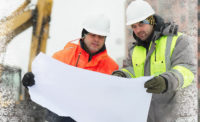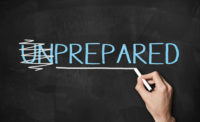Employees in the metal forming, textile- and furniture-making, oil well rigging and servicing, and construction industries are most at risk for hearing loss. But in any industry, if your employees’ noise exposure is 85 decibels or higher averaged over an eight-hour period, you must create a hearing conservation program, according to OSHA regulation 29 CFR 1910.95. This article
covers six important steps for creating an effective hearing conservation program:
1. Noise monitoring
Using a sound-level meter, you (and possibly an industrial hygienist) should perform a noise survey in work areas that might have problems. Measurements must be taken at different times during the day to estimate noise exposure over various work shifts.If your employees enter and leave noisy areas throughout the day, or if noise levels fluctuate greatly, you might want to conduct “personal monitoring” with a dosimeter, which attaches to an employee’s clothing and provides an exposure measurement over a particular time period.
2. Reduce noise levels
If monitoring reveals that your workers are exposed to high noise levels, try to reduce the noise through engineering or administrative controls.Engineering controls can include enclosing machines behind soundproof barriers, dampening vibration of components, maintaining or replacing worn parts, substituting quieter machines or processes, or isolating the operator in a soundproof booth.
Administrative controls involve rotating employees from high noise-level areas to low noise-level sites throughout the work shift.
3. Audiometric testing
If you still have areas with noise levels over 85 decibels — OSHA’s action level — you must conduct audiometric (hearing) tests. A baseline audiometric test must be completed within six months of an employee’s first exposure to noise levels above the action level. Testing should be repeated every year.Trained in-house personnel can conduct audiometric monitoring, but you might find it more convenient to hire an outside consultant. However, anyone who performs audiometric tests is required by OSHA to report to an audiologist or other specialist.
Employees must be informed of the results, provided with appropriate hearing protection, and referred for a clinical audiological evaluation if hearing loss has occurred.
4. Hearing protection
Along with audiometric testing, you are required to provide proper hearing protection for employees who are exposed to noise over the action level. Look for protectors with a noise reduction rating (NRR) of at least 20 decibels, and offer workers a choice of suitable hearing protectors — earplugs, canal caps, and earmuffs. Not only does OSHA require you to provide a choice of protective devices, but your employees won’t wear protection that is uncomfortable.5. Training
Don’t just hand out hearing protectors and expect employees to know what to do with them. Train your workers every year in the following three areas:- The effects of noise on hearing;
- An explanation of audiometric testing; and
- How to use and maintain hearing protectors.
6. Recordkeeping
OSHA standards require that you maintain accurate records of all exposure measurements and audiograms. You should keep noise-exposure records for two years, and audiometric testing results should be kept throughout a worker’s employment. Also, certain hearing losses should be recorded on OSHA Form 200 under “Illnesses.”Sidebar: Do's and Don'ts
To help protect your employees’ hearing:- Properly maintain machines to reduce noise levels
- Ensure that hearing protectors are worn by employees in high-risk areas
- Ensure that all hearing protectors fit well and are in good condition
- Test employees’ hearing if they report noise or ringing in their ears or have trouble hearing people speaking or hearing high or soft sounds.
Be sure your employees don’t:
- Tamper with hearing-testing or noise-reduction equipment
- Forget to use hearing protection
- Use hearing protectors that are loose or cracked
- Use hearing protectors that don’t fit snugly, over or into the ear
- Use homemade hearing protection — cotton balls, stereo headsets, etc. These devices don’t provide protection.
Sidebar: Getting rid of noise
If sound monitoring reveals high noise levels, OSHA recommends trying to quiet things down through engineering or administrative controls, which isn’t as difficult or expensive as you might think. We found several solutions that helped to drastically reduce noise levels in our facility, which makes upholstered chairs.For instance, simple maintenance — replacing bearings in our woodworking routers — helped bring levels down. We also moved exhaust fans from inside the facility to the rooftop. We had one fan that couldn’t be moved, so we placed rubber flanges around the housing.
Proper use of the correct equipment will reduce noise levels, too. Originally our brazing torches were emitting over 90 decibels because employees were using oversized nozzles and cranking up the fuel flow, which made the torches loud (and the welds brittle). Switching to the correct nozzles and flow rate lowered the sound level and improved the quality of the work.
If noise cannot be engineered out, try enclosing it. We built sound barriers around our loud woodworking machines, such as planers and form shapers. The planer is actually in a small room with a conveyor going in and out. Our shapers are enclosed in plywood barriers with heavy plastic curtains at the entrance. In addition, the interior of both enclosures is covered with thick fabric to help muffle noise.
If engineering controls won’t do the trick in your facility, try administrative options, which involve rotating employees in and out of high noise areas.
By Roger Simpson, CSP, CHMM, safety and environmental director for Shelby Williams in Morristown, Tenn. Roger can be reached at (423) 586-7000 x372.


